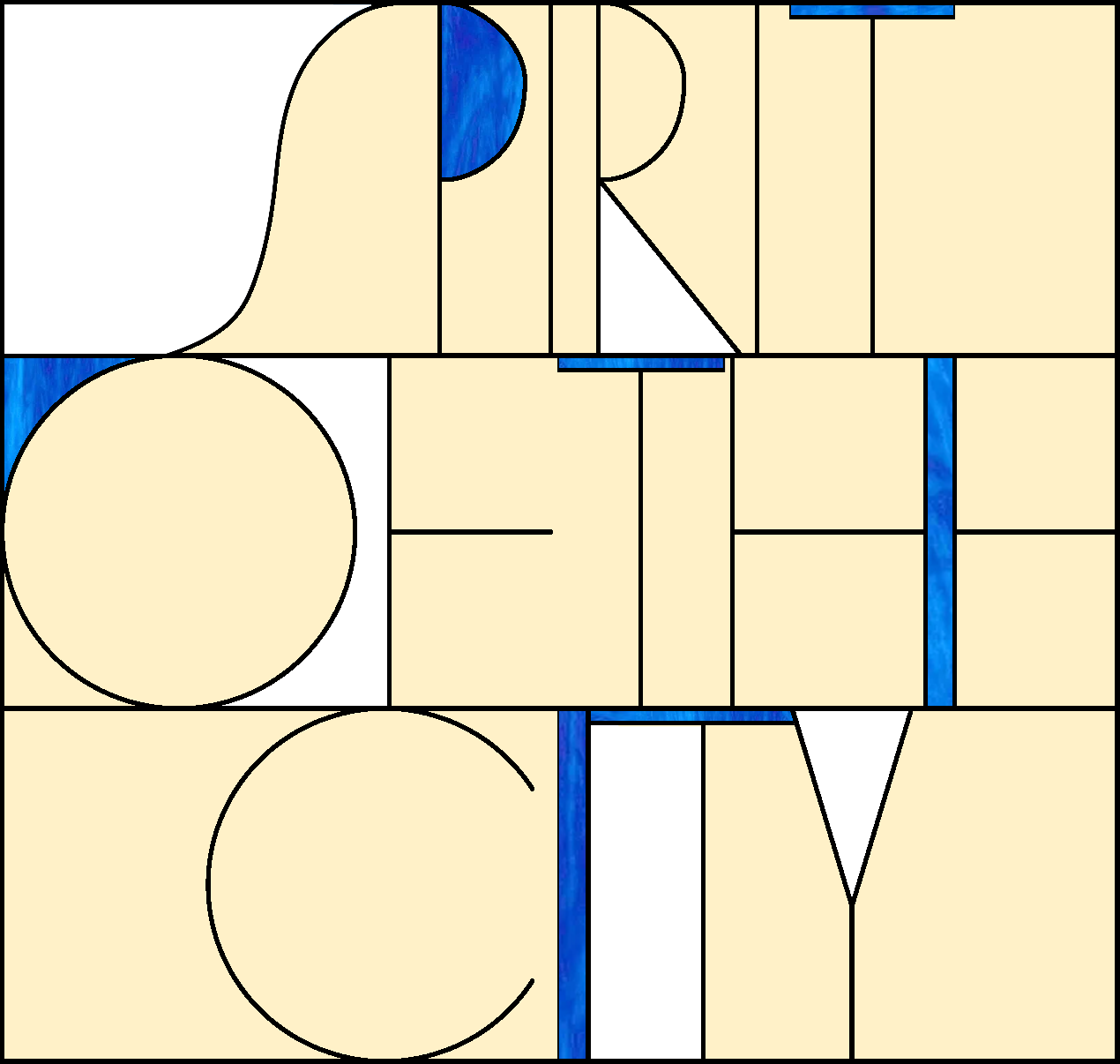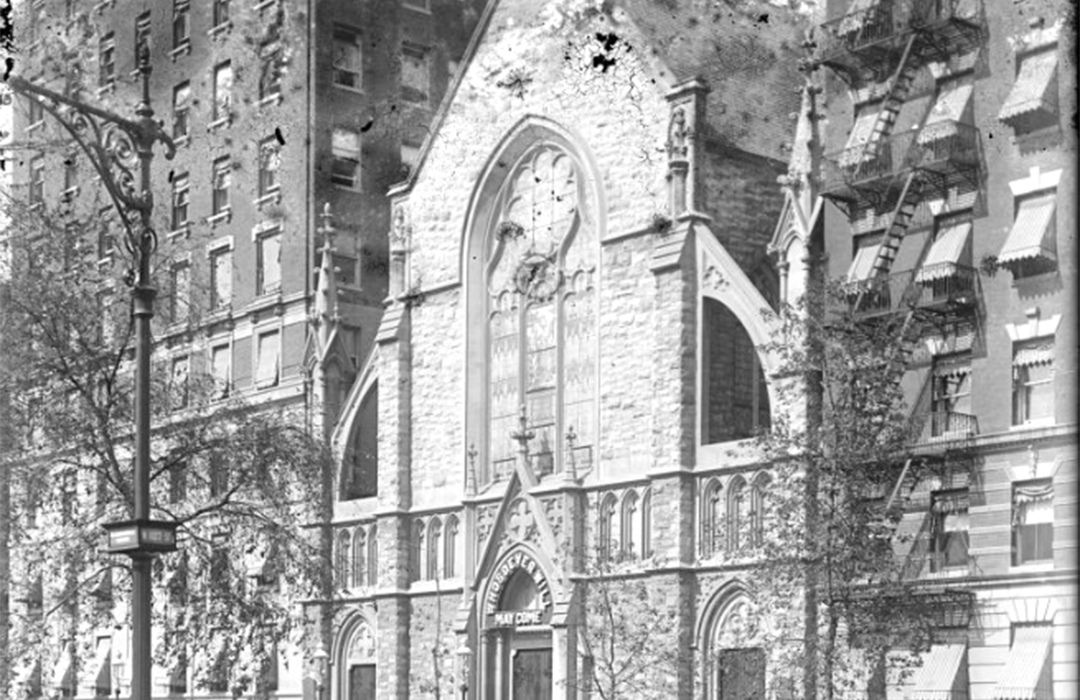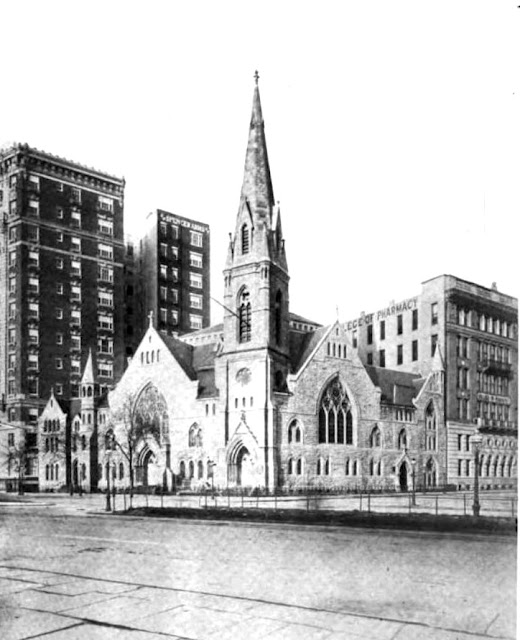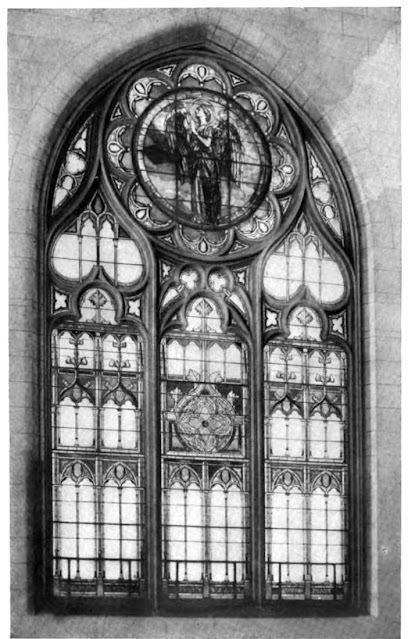
Bloomingdale Reformed Church
949 West End Avenue
by Tom Miller
In 1805, the village of Harsenville occupied the area known today as Lincoln Square, far to the north of New York City. That year, a group of residents headed by Jacob Harsen established the Bloomingdale Reformed Dutch Church. Over the subsequent decades the congregation swelled, as did its finances. In 1884, architect Samuel B. Reed designed a large Gothic Revival church structure at the northeast corner of Broadway and 68th Street.
In 1905, according to Hopper Striker Mott in his 1908 The New York of Yesterday, the congregation concluded (not “without some opposition”) that “the neighborhood was ‘overchurched.'” Within a half-mile radius were three Episcopal, two Presbyterian, two Lutheran, one Reformed, one Congregational, one Methodist, and one Christian Science church. On April 24, negotiations were completed for the sale of the Broadway property for $260,000, and lots on West End Avenue midblock between 106th and 107th Street were purchased for $160,000. The new site faced what was then known as Bloomingdale Square. The two transactions left the congregation with a comfortable building fund.
The 1885 structure was beloved by congregants, and, according to Hopper Striker Mott, “it was determined to take down the edifice stone by stone and put it together again at the new location.” The architectural firm of Ludlow & Valentine was commissioned to carry out the ungainly scheme.
the congregation concluded (not “without some opposition”) that “the neighborhood was ‘overchurched.’
The firm’s plans were filed in July 1905. Ludlow & Valentine placed the construction costs at $70,000, or about $2.4 million in 2023. Four months later, on November 12, the cornerstone was laid. The Christian Intelligencer said the service “was impressive in its orderly dignity.”
Deconstruction of the Broadway building proceeded carefully, slowing the progress on the new structure. Workmen conscientiously removed limestone blocks so they could be reused in the new church.
Nearly a year later, on October 7, 1906, the first service was held in the still uncompleted structure. It came the day after New Yorkers read of a macabre incident at the Broadway site. With the old church structure removed, workmen began excavating the crypt below ground where 121 bodies were interred. The New-York Tribune reported, “the removal was delayed because of the condition in which the bodies were found.” The article continued:
The coffins have entirely rotted away, and all that indicates that they ever occupied the vault are a few pieces of decayed wood not yet disintegrated. The flesh of the bodies long ago changed to dust. The remnants of the coffins and of the bodies are mingled, forming a heap of dust and human bones. The work is made more difficult by the lack of a masonry bottom to the vault.
Ludlow & Valentine, of course, could not reproduce the large Broadway building, which sat on a corner lot, within the midblock site. However, they valiantly emulated its architectural spirit, nearly copying the Gothic-arched entrance below a large stained glass window. Especially interesting were the flying buttresses that sprung from either side of the midsection. Hopper Striker Mott said, “Taken as a whole, it forms one of the most beautiful of the many fine churches which adorn the west side.”
The interior was faced in stone, “presenting the aspect of a cathedral,” according to Mott. The pews and other furnishings were of oak and upholstered in green. What remained of the 121 bodies removed from the old crypt now reposed in a “receptacle built in the wall,” with the original memorial tablet from the former church reinstalled on the wall.
There would be two magnificent memorial windows, dedicated in separate services on December 30 1906. The first, the Pyatt window, was dedicated that morning. Runyon Pyatt was an elder of the church whose family arrived in America on the Mayflower. The window, designed by John La Farge, was dedicated to his parents.
Receiving considerable more press attention was the Gilbert Window, also designed by La Farge, which was dedicated at the afternoon service. Anne Hartley Gilbert, known to theater audiences as Mrs. G. H. Gilbert, had been a member of the Bloomingdale Reformed Church for years. The New York Times wrote, “So far as known, this window is with one exception, the only one in any church in this country erected in memory of a member of the theatrical profession.” (The other was the window to the memory of actor Edwin Booth in the Church of the Transfiguration, or “The Little Church Around the Corner.”)
The dedication service was attended by a who’s who of the New York theater, including producers Charles and Daniel Frohman and world-famous actors Annie Russell, Maude Adams, and John Drew. Yet Hopper Striker Mott noted, “The stage friends of the late actress were greatly outnumbered by those of the congregation that knew her apart from her profession.”
on April 30, 1913–just seven years after the Bloomingdale Reformed Church was completed–that developer and builder Harry Schiff had purchased the property for $300,000.
At a time when religious leaders most often considered the theater a place of immorality, the memorial within a church was notable. The New York Times reported that in his address, Dr. William C. Stinson called Mrs. Gilbert “a woman whose virtues reflected honor on the Church and on the stage.”
Dr. Stinson’s esteem of Anne Hartley Gilbert did not dilute his ability to criticize the theater at large. In his sermon on February 14, 1909, he lashed out at the production of Salome at the Manhattan Theatre. In reporting on his heated comments, The New York Times mentioned, “This church contains a window in memory of Mrs. William Henry Gilbert, the actress, who was spoken of as ‘the saintliest old lady of the modern stage.'” There was nothing saintly in the play Salome, according to Dr. Stinson.
But while decrying the producers for staging the production, he blamed theater-goers for inducing them to do so. “If the public wants to pay the price for exhibitions of gross barbaric lewdness, with musical accompaniment, however much their souls may be debauched in the meanwhile, why, that is their concern.”
New Yorkers were no doubt astounded when they read in the New-York Tribune on April 30, 1913–just seven years after the Bloomingdale Reformed Church was completed–that developer and builder Harry Schiff had purchased the property for $300,000. Calling it “a deal of more than ordinary interest to the west side,” the newspaper said it “means the passing away of one of the fine church edifices in that part of the city and the use of the site for a big apartment house.” Before the church was demolished, the Gilbert Window was removed to the Hamilton Grange Reformed Church on Convent Avenue. Shortly afterward, the Bloomingdale Reformed Church congregation disbanded.
Tom Miller is a social historian and blogger at daytoninmanhattan.blogspot.com




